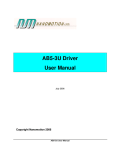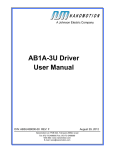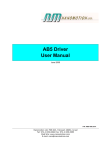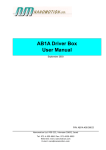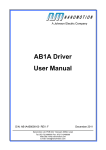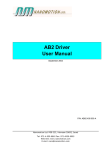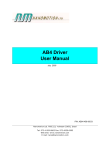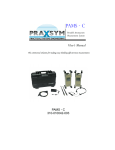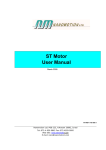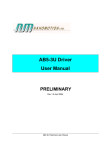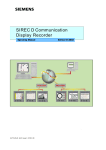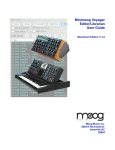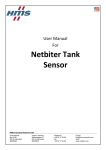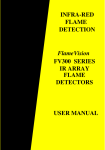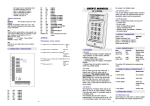Download AB1A-3U Driver User Manual
Transcript
AB1A-3U Driver User Manual March 2004 P/N: AB3U-458-000-C Nanomotion Ltd. POB 223, Yokneam 20692, Israel Tel: 972-4-959-0862 Fax: 972-4959-0995 Web Site: ww w.nanom otion.net E-mail: [email protected] Copyright Copyright This document contains proprietary information of Nanomotion Ltd., and Nanomotion Inc., and may not be reproduced in any form without prior written consent from Nanomotion Ltd. and Nanomotion Inc. No part of this document may be reproduced, translated, stored in a retrieval system or transmitted in any form and by any means, electronic, mechanical, photographic, photocopying, recording, or otherwise, without the written permission of Nanomotion Ltd. Information provided in this document is subject to change without notice and does not represent a commitment on the part of Nanomotion Ltd. Copyright March 2003, Yokneam, Israel. All rights reserved. All products and company names are trademarks or registered trademarks of their respective holders. Limited Warranty Nanomotion Ltd. (hereinafter NM) warrants the product (other than software) manufactured by it to be free from defects in material and workmanship for a period of time of one year (except those parts normally considered as consumable/expendable components such as motor conditioning brushes). The warranty commences thirty (30) days from the date of shipment. NM warrants those parts replaced under warranty for a period equal to the remaining warranty coverage of the original part. NM’s sole and exclusive obligation under this warranty provision shall be to repair, or at its sole option exchange defective products or the relevant part or component, but only if: (i) the Purchaser reports the defect to NM in writing and provides a description of the defective product and complete information about the manner of its discovery within ten (10) days of its discovery; (ii) NM has the opportunity to investigate the reported defect and determines that the defect arises from faulty material, parts or workmanship; and (iii) the Purchaser returns the affected product to a location designated by NM. These provisions constitute the exclusive remedy of the Purchaser for product defects or any other claim of liability in connection with the purchase or use of NM products. This warranty policy applies only to NM products purchased directly from NM or from an authorized NM distributor or representative. This warranty shall not apply to (i) products repaired or altered by anyone other than those authorized by NM; (ii) products subjected to negligence, accidents or damage by circumstances beyond NM control; (iii) product subjected to improper operation or maintenance (i.e. operation not in accordance with NM Installation Manuals and/or instructions) or for use other than the original purpose for which the product was designed to be used. NM shall not in any event have obligations or liabilities to the Purchaser or any other party for loss of profits, loss of use or incidental, increased cost of operation or delays in operation, special or consequential damages, whether based on contract, tort (including negligence), strict liability, or any other theory or form of action, even if NM has been advised of the possibility thereof, arising out of or in connection with the manufacture, sale, delivery, use, repair or performance of the NM products. Without limiting the generality of the preceding sentence, NM shall not be liable to the Purchaser for personal injury or property damages. a CE Compliance CE Compliance This product has been tested for Electric Safety and Electromagnetic Compatibility inside a closed shielded metal cabinet and was found to be in compliance with the following directives and standards: EMC Directive 89/336/EEC FCC 47 CFR part 15 subpart B. LVD directive 73/23/EC, Article 5 EN 61800-3:1996 + A11: 2000 for second environment EN 61000-3-2:2000, EN 61000-3-3:1995 + A1: 2001 FCC 47 CFR: 2002 part 15, subpart B, class A EN 61010-1:2001 b Table of Contents Table of Contents 1 AB1A-3U DESCRIPTION.....................................................................................................1 1.1 General ........................................................................................................................1 1.2 Main Features ..............................................................................................................1 1.3 Operating Principles ....................................................................................................1 1.4 Operation Modes .........................................................................................................3 1.4.1 Velocity Mode Operation..................................................................................3 1.4.2 Step Mode Operation .......................................................................................4 1.4.2.1 Enabling the Step Mode ................................................................................4 1.4.3 Gate Mode Operation.......................................................................................4 1.4.3.1 1.5 Enabling the Gate Mode................................................................................4 Using the AB1A-3U to Drive LS Motors ......................................................................5 2 CONNECTIONS AND I/O SETTINGS .................................................................................6 2.1 Motion Controller Connection......................................................................................6 2.2 Cable Connections ......................................................................................................7 2.2.1 Shielding...........................................................................................................7 2.3 Motor Connections.......................................................................................................7 2.3.1 Motor Cable Length..........................................................................................8 2.4 Opto-isolated Inputs.....................................................................................................9 2.4.1 Voltage Source Configuration ..........................................................................9 2.5 Fault Output ...............................................................................................................10 2.6 LED Indicators ...........................................................................................................10 2.7 Before Operating the Motor .......................................................................................11 3 SPECIFICATIONS ..............................................................................................................12 3.1 Parameters and Conditions .......................................................................................12 3.2 AB1A-3U Layout ........................................................................................................13 3.3 AB1A-3U Pin Arrangement........................................................................................14 c List of Figures List of Figures Figure 1: AB1A-3U Block Diagram .......................................................................................2 Figure 2: Schematic Diagram of the Output Stage with an Internal LC Card ......................3 Figure 3: Differential Analog Input Connection.....................................................................6 Figure 4: Non-Differential (single ended) Analog Input Connection. ...................................7 Figure 5: J1 Connection to a Motor or Branch Cable ...........................................................8 Figure 6: Jumper 2 Configuration .........................................................................................9 Figure 7: Opto-Isolated Input Interface ...............................................................................10 Figure 8: LED Indicators .....................................................................................................11 Figure 9: AB1A-3U Layout ..................................................................................................13 List of Tables Table 1: AB1A-3U Power Consumption .............................................................................12 Table 2: Electrical Specifications ........................................................................................12 Table 3: Environmental Conditions.....................................................................................12 Table 4: Analog Input Specifications ..................................................................................13 Table 5: Dissipated Heat.....................................................................................................13 Table 6: Input/Output Connector Pin Out ...........................................................................14 Nanomotion Ltd. d List of Abbreviations List of Abbreviations A Ampere AC Alternating Current DC Direct Current LC Coil Capacitor Resonance Circuit LED Light Emitting Diode mA Milliampere mW Milliwatt TTL Transistor-Transistor Logic Vrms Volts Root Mean Square HIGH VOLTAGE ON CARD. ATTENTION: OPERATE ONLY INSIDE A CLOSED, SHIELDED METAL CABINET. e AB1A-3U Description General 1 AB1A-3U Description 1.1 General The AB1A-3U is a single-axis motor driver designed to drive up to 32 motor elements in parallel. The motor types that can be driven by AB1A-3U are HR, LS, ST and STM. 1.2 1.3 Main Features • High precision (11 bits) control of the power output stage • Drives up to 32 Nanomotion motor elements in parallel • Interfaces with an Analog command • Discrete inputs enable feedback from external sources, such as limit switches, emergency stop command, etc. • LED indicators • Output short circuit protection • Reduced sensitivity to cable length and capacity Operating Principles The AB1A-3U Driver comprises the AB1A-3U main card and an LC card. The AB1A-3U Card converts the analog input command signal into a corresponding PWM square wave output signal that is fed to the LC Card. The LC Card produces the sine wave output voltage that drives the motor. The LC Card type and configuration depends on the number of motor elements driven. • For 1 to 16 elements, the LC circuit is internal to the AB1A-3U • For 32 elements, the LC circuit is external to the AB1A-3U (LC Box) 1 AB1A-3U Description Operating Principles An internal DC-to-DC converter that is fed from an external +48V power supply supplies the required DC voltages. Figure 1 illustrates a typical application of the AB1A-3U Driver. Figure 1: AB1A-3U Block Diagram The motor has three terminals: “UP” (red wire), “DOWN” (white wire) and “COMMON” (black wire). The voltage applied between the “UP” and the “COMMON” terminals causes the motor to move in one direction, while voltage applied between the “DOWN” and the “COMMON” terminals causes the motor to move in the opposite direction. Figure 2 is a schematic drawing of the power output. Nanomotion Ltd. 2 AB1A3U Driver User Manual AB1A-3U Description AB1A3U PWM - Square wave on the amplifier output +48v H-BRIDGE AC output that drives the motor LC Card "Common" "Phase" "Up" UP COMMON "Down" DOWN DIRECTION CONTROL NANOMOTION MOTOR Figure 2: Schematic Diagram of the Output Stage with an Internal LC Card 1.4 Operation Modes The AB1A-3U can be operated in one of the following operation modes: • Velocity Mode, in which the motor is driven continuously. • Gate Mode, in which the motor is driven at low velocity by turning the driver output ON and OFF in time intervals defined by outside TTL signal in an open loop. • Step Mode, in which the driver output is turned OFF and ON at predefined intervals, in order to drive the motor in discrete steps. 1.4.1 Velocity Mode Operation In this operation mode, the motor is driven continuously by applying the analog command voltage (± 10 V) using a relevant interface device (joystick or motion controller). 3 AB1A-3U Description Operation Modes 1.4.2 Step Mode Operation In this operation mode the motor is turned on and off for fixed time intervals defined in the hardware as follows: • ON phase - 1/16 second • OFF phase - 0.5 second The amplitude of the output corresponds to the analog input value and thus determines the speed of the motor. 1.4.2.1 Enabling the Step Mode In order to enable the Step Mode, the B10 pin (see Table 6) should be shorted to the ground. By default, neither B10 nor Z14 (see section 1.4.3.1) is shorted to the ground, so that the user can select the required conection. 1.4.3 Gate Mode Operation In this operation mode the motor is driven in open loop at low velocities by turning the driver output ON and OFF in time intervals defined by an external switching. The amplitude of the output corresponds to the analog input value and thus determines the speed of the motor. In Gate Mode, as opposed to Step Mode, the pulse width and pulse frequency are userdefined. The allowable parameter values for the external signal are as follows: • Voltage level: 0V(on); 5V(off). Open collector logic is also an option. • Minimum pulse width: 50 µsec • Maximum pulse frequency: 1 kHz 1.4.3.1 Enabling the Gate Mode In order to enable the Gate Mode, the Z14 pin (see Table 6) should be shorted to the ground. Verify that the B10 pin is not shorted to the ground at the same time. Once Z14 is shorted to the ground, the driver is in Gate Mode. Conduct now the external switching signal through pin B10 (see also section 1.4.2.1). Nanomotion Ltd. 4 AB1A3U Driver User Manual AB1A-3U Description 1.5 Using the AB1A-3U to Drive LS Motors Under normal conditions, the LS series of motors should not be operated with command voltage exceeding 3.5V. To allow some margin in cases, which require momentarily use of higher power, the AB1A-3U for the LS series of motors is limited to 5V. Nanomotion expects that during normal operation, the commanding controller should protect the motor, and assumes that in continuous operation the command will not exceed 3.5V. The protection scheme is as follows: the torque limit at the controller must be set to half of the maximum command voltage (5V), and be limited to 5 seconds. The controller RMS torque limit must be set to 35% of the full command. 5 AB1A3U Driver User Manual Connections and I/O Settings 2 Connections and I/O Settings 2.1 Motion Controller Connection There are two options of connecting a motion controller to the AB1A-3U driver: • Differential connection (see Figure 3) • Single-Ended Connection (see Figure 4) The differential connection enhances noise immunity. AB1A-3U Vin+ From controller Vin- Figure 3: Differential Analog Input Connection 6 AB1A3U Driver User Manual Connections and I/O Settings AB1A-3U Vin+ From controller Vin- Gnd Figure 4: Non-Differential (single ended) Analog Input Connection. 2.2 Cable Connections Connect the following groups of cables together, isolating each of the signals: • POWER SUPPLIES – use 22 AWG (or lower AWG) wires for the power supplies. For noisy surroundings, it is recommended to twist the ground line and the power line together. • ANALOG COMMAND – a twisted shielded cable is recommended. • DISCRETE INPUTS – These signals are not sensitive to noise and can be grouped together in the same harness with any of the other groups. 2.2.1 Shielding As the high motor voltage is induced on the cable shield, it is required to ground the shield on both motor and driver sides to the infrastructure earth. 2.3 Motor Connections The “Motor Disconnect” signal is available only at the motor (or branch cable) connector, where it is shorted to ground. This ensures that unprotected motor pins will not be exposed to high voltage when the motor is not connected. If more than one motor is connected to the AB1A-3U Driver Box, use a suitable branch cable or extension cable, as supplied by Nanomotion. If the motor type or the number of motor elements is changed, consult Nanomotion for the appropriate LC Card configuration and other driver configuration changes that may be required. 7 Connections and I/O Settings Motor Connections Figure 5: J1 Connection to a Motor or Branch Cable 2.3.1 Motor Cable Length The overall length of the cables that connect the AB1A-3U driver to the motor elements should be in accordance with the following: • Up to 2 motor elements – 5m • 4 – 32 motor elements – 10m NOTE: NOTE: Nanomotion Ltd. 8 Use Nanomotion standard cables. Branching is possible to 2 and 4 identical motors. Branch cables must be of identical length, the sum of which not exceeding the allowed total cable length. Nanomotion can guarantee proper driver and motor performance only when Nanomotion standard cables are used. AB1A3U Driver User Manual Connections and I/O Settings 2.4 Opto-isolated Inputs The following inputs are opto-isolated and are activated by shorting them to ground (see also Table 6): • Powering Up/Down ♦ Motor Connected: Safety input. The motor operation is enabled only when this input is shorted to the ground. ♦ Enable: Enables the motor activation ♦ Emergency Stop (ES): Disables the AB1A-3U output • Mode Enabling ♦ Step Mode: Enables Step Mode operation • Direction Restrictions ♦ Left Switch: Disables motor motion to the left ♦ Right Switch: Disables motor motion to the right 2.4.1 Voltage Source Configuration The opto-isolated input signals are activated as short-to-ground. The voltage for the opto-isolated circuit (see Figure 7) is provided by either the internal +5V supply (default setting) or an external voltage supply via pin 20 on the I/O Port connector. The input to be activated should be shorted to external voltage supply ground. Configure jumper JP 2 (located near LC card) on the AB1A-3U card according to the voltage source: • Pin 1 shorted to Pin 2, for an internal +5V source (factory setting) • Pin 2 shorted to Pin 3, for an external voltage source ATTENTION: Do not short Pin 1 to Pin 3 on JP2. Doing so shorts the external power supply to the +5V supply! The input circuit is limited to sink up to 10 mA but not less than 3 mA. Internal voltage source External voltage source Figure 6: Jumper 2 Configuration 9 Connections and I/O Settings Fault Output VCC JP2 1 User Voltage VCC 390Ω To control logic Command Input AB1A-3U Figure 7: Opto-Isolated Input Interface 2.5 Fault Output Fault: An open collector logic output that is active shorted to ground under the following conditions: • Over Current • The motor is not connected and the “Motor Disconnect” signal is floating • Emergency Stop NOTE: 2.6 The Fault output is capable of sinking a maximum of 20 mA, and is not protected from over current. LED Indicators There are five LED indicators located on the front side of the card. See Figure 8 for LEDs’ locations. • Power ON. Green LED. Lights when 48V is applied • Fault. Red LED. Lights when over current protection is triggered. • Motor Disabled. Red LED. Lights when motor is connected and the driver is disabled. • Motor Not Connected (NC). Red LED. Lights when motor is not connected. • Motor Enabled. Green LED. Lights when drive is enabled. Nanomotion Ltd. 10 AB1A3U Driver User Manual Connections and I/O Settings Motor Enabled Motor NC Motor Disabled Fault Power on Figure 8: LED Indicators 2.7 Before Operating the Motor Before operating the AB1A-3U, verify the following: Card configuration (as specified on card) matches the motor to be operated, Jumper JP2 is set to the required mode of operation. The external power supply is capable of supplying the required power consumption of the AB1A-3U. There is no command when switching the power to “ON”. Make sure that all motors that are to be driven by the AB1A-3U are preloaded. ATTENTION: The command should be limited according to the envelope of performance of the motor. Refer to the Motor User Manual. 11 Specifications Parameters and Conditions 3 Specifications 3.1 Parameters and Conditions Table 1: AB1A-3U Power Consumption Power Input +48VDC ±5% (stabilized) Max Motor Output 250-290 Vrms Power Consumption without Load +48VDC/0.125A Power Consumption with Max load +48VDC/6.5A max Table 2: Electrical Specifications Supply Voltage +48v ±5% Current Consumption Used When ≤ 200 mA 1x HR1 is connected. ≤ 500 mA 1x HR2 is connected. ≤ 800 mA 1x HR4 is connected. ≤ 1200 mA 1x HR8 is connected. The required power supply value should be calculated by adding the total power consumption of all the motors that are connected to the AB1A-3U power consumption without motor (+48VDC/125 mArms) according to the following: • I = 125mA + n*(current consumption of a single motor) • n = Number of motors that are connected (n= 1/2/3/4). Table 3: Environmental Conditions Operating Temperature 0°C to 50°C Storage Temperature -40°C to 70°C Operating Humidity Up to 80%, non-condensing. Nanomotion Ltd. 12 AB1A3U Driver User Manual Specifications Table 4: Analog Input Specifications Input voltage range: ±10V Input impedance: 10 kΩ Input low pass filter: 2.7 kHz Table 5: Dissipated Heat Configuration Input Power (W) Motor Power (W) Dissipated Heat (W) HR1 9.6 6.0 3.6 HR2 19.2 12.0 7.2 HR4 38.4 24.0 14.4 HR8 56.7 48.0 8.7 2HR8 96.0 77.5 18.5 4HR8 230.0 192.0 38.0 STM 7.2 4.0 3.2 * The values given in Table 5 are nominal. 3.2 AB1A-3U Layout Figure 9: AB1A-3U Layout External connector: P/N ERNI 334203, male. Mating connector: P/N ERNI 344265, female. 13 Specifications AB1A-3U Pin Arrangement 3.3 AB1A-3U Pin Arrangement Table 6: Input/Output Connector Pin Out Pin Signal Name B10 Step Input Step mode (see sections 1.4.2.1 and 2.4) Z10 Enable Input Drive enable (see section 2.4) D12 Emergency stop Input Safety input. Disables the drive. (See section 2.4) D16 Right Switch Input Digital Input For Right Limit Switch (See section 2.4) B16 Left Switch Input Digital Input For Left Limit Switch (See section 2.4) B30, Z30 Motor connected Input Safety input. The motor operation is enabled only when this input is shorted to the ground (see section 2.4). Z14 Gate Input Gate Mode (see sections 1.4.3.1 and 2.4) B12 Fault Output Open collector. (see sections 2.5) D18, D26 VIN - Input Negative analog command input (0 to –10V) B18, B26 VIN + Input Positive analog command input (0 to +10V) D22, B22 Motor COMMON Output Connected to the motor ‘COMMON’ terminal (black wire) D24, B24 Motor DOWN Output Connected to the motor ‘DOWN’ terminal (white wire) B28, Z28 Motor UP Output Connected to the motor ‘UP’ terminal (red wire) B32, Z32 Motor Phase in Output Used with an external LC box configuration. Otherwise not used. D8, 48V B8, Z8 Input Power supply D10 User voltage AUX input 5V External supply D2 -12V AUX input Accessory voltage for powering an external component (max 700 mW). Return is the GND pin. D6 +12V AUX input Accessory voltage for powering an external component (max 700 mW). Return is the GND pin. Nanomotion Ltd. 14 Function Description AB1A3U Driver User Manual Specifications Pin Signal Name Function Description B6 Vcc Z2 SER_CLK - Optional. Consult factory. B2 CS - Optional. Consult factory. AUX output D4, GND B4, Z4 5V Accessory voltage for powering an external component (max 2.5W). Return is the GND pin. Ground - Z6 SER_DATA Z12 Reset D14 Reserved For future use. Must be left unused. Z16 PTC For future use. Must be left unused. Z18 NC Not in use D20, B20 Motor phase Z20 NC Not in use Z22 GND Ground Z24 GND Ground Z26 GND Ground D28 GND Ground D30 NC Not in use D32 NC Not in use Input Output Optional. Consult factory. System initialization. Acivated short to ground Used with an external LC box configuration. Otherwise not used. 15























